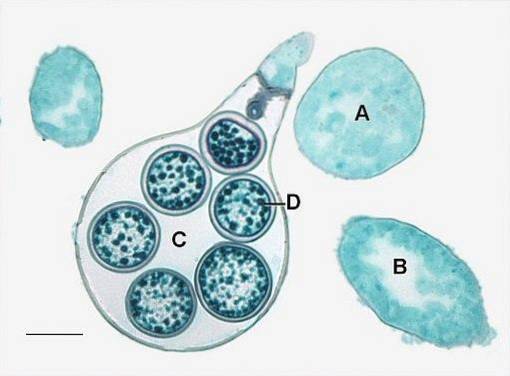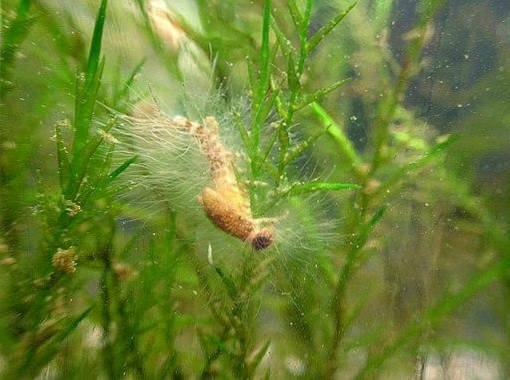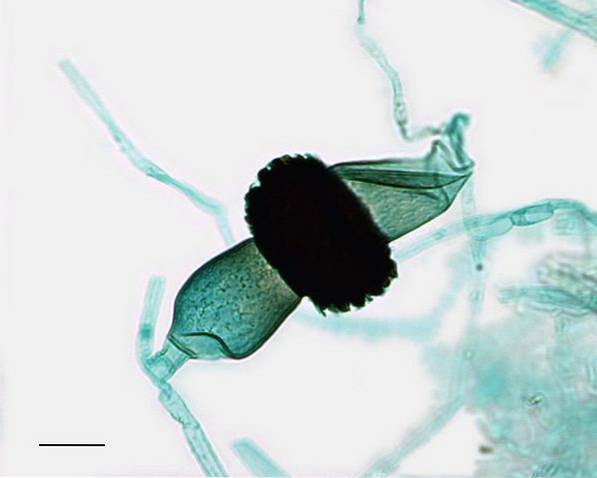
What is plasmogamy?
The plasmogamy It is a phase of sexual reproduction in which the fusion of the cytoplasms of the gametes or sex cells occurs, without the fusion of their nuclei. Plasmogamy is common in fungi, being the first stage of their sexual reproduction. It can also occur in plant and animal cells that have been fused and cultured..
Gametes are special cells, differentiated from the other cells of an organism, due to their morphology and the reproductive function they fulfill. In some cases, the process of plasmogamy occurs not between differentiated gametes but between undifferentiated somatic cells (somatogamy-type plasmogamy).

After a period of intensive growth, the fungi enter a reproduction phase, forming and releasing large numbers of spores. The spores are generally unicellular and are produced by fragmentation of the mycelium or within specialized structures such as sporangia, sporophores or gametangia, among others..
The spores can be produced asexually or indirectly in sexual reproduction. Sexual reproduction in fungi, as well as in other organisms, involves the fusion of two nuclei that contain the genetic information of each parental individual. Nuclei physically meet when two sex cells or gametes unite.
Article index
- 1 Stages of sexual reproduction of fungi
- 1.1 Plasmogamy
- 1.2 Caryogamy
- 1.3 Meiosis
- 2 Types of plasmogamy
- 2.1 Fusion of gametes
- 2.2 Gametangial copulation
- 2.3 Fusion of gametangia
- 2.4 Spermatization
- 2.5 Somatogamy
- 3 Advantages and disadvantages of sexual reproduction
- 4 References
Stages of sexual reproduction of fungi
Sexual reproduction can be defined as a mechanism that constantly renews the genetic load of the individuals of a biological species. It is an important source of genetic variability, which allows a greater capacity to adapt to new environmental conditions..
The process of sexual reproduction of fungi has unique and particular characteristics of this kingdom.
In other eukaryotic organisms (with nuclei and organelles enclosed with membranes), such as plants, animals and protists (very simple eukaryotes, without differentiated tissues), cell division involves the dissolution and reconstruction of the nuclear membrane.
In fungi, the nuclear membrane remains intact throughout the entire process; in some species, which are the exception, the nuclear membrane breaks but only partially.
The sexual reproduction of fungi takes place in three stages: plasmogamy, karyogamy, and meiosis. The duration of each event or stage of sexual reproduction varies and the intervals between these events are also variable, depending on the type of organism..
In primitive, less evolved fungi, karyogamy occurs almost immediately after plasmogamy. On the other hand, in higher, more evolved fungi, there is an interval between both stages.
Plasmogamy
Plasmogamy or cell fusion is the first stage of sexual reproduction in fungi, where two gametes that are genetically different haploid cells fuse, resulting in a cell with two haploid nuclei. In plasmogamy only the cytoplasms of the two parental haploid gametes unite.
Haploid cells contain a single set of chromosomes and are represented as: n. Diploid cells have two sets of chromosomes; are symbolized as: 2n.
Karyogamy
In the next stage, called karyogamy, the fusion or union of the two haploid nuclei of the parental gametes occurs, giving rise to a cell with a diploid nucleus..
With the fusion of the nuclei, a new cell called a zygote is produced. The nucleus of this zygote contains a doubled number of chromosomes (i.e. it is diploid or 2n).
Meiosis
Meiosis is the last stage of sexual reproduction, where the number of chromosomes is again halved. In meiosis, one diploid cell (2n) produces four haploid cells (n).
In meiosis, chromosome recombination processes also occur that guarantee that the genetic composition (or genetic load) of the new cells is different from that of the precursor gametes of the entire process..
Types of plasmogamy
Fungi employ a variety of methods to join two haploid nuclei of compatible cells, that is, for plasmogamy to occur..
Plasmogamy occurs more frequently in cells that do not differ in morphology and in this case it is called isogamy. When the cells that fuse their cytoplasms are of different size, plasmogamy is called anisogamy..
There are 5 main types of plasmogamy which are the following: gamete fusion, gametangial copulation, gametangial fusion, spermatization and somatogamy. These types of plasmogamy are described below..
Gamete fusion
Some fungi produce specialized sex cells (gametes) that are released from sex organs called gametangia, as we saw earlier..
Unicellular gamete fusion occurs in the event that both or at least one of them is mobile. The mobility of the spores depends on their having flagella that allow them to propel themselves to swim, in which case they are called zoospores. Generally, the two gametes that fuse are the same size and are called isogamic zoospores..
It may occasionally be the case that one gamete is larger than the other (anisogamic gametes). In the genre Monoblepharis from the phylla Chytridiomycota, the motile male gametes are released from the male gametangium or antheridium.
Later, male gametes penetrate a female gametangium (called oogonium) and fertilize large, immobile female gametes (called oospheres)..
Gametangial copulation
In other fungi, two gametangia come into contact and the nucleus passes from the male to the female gametangium. In this case, the gametangia fulfill the functions of gametes.
This type of plasmogamy occurs in organisms of the Oomycota group, in which small male gametangia (antheridia) produce fertilization tubes that grow, branch and then fuse with the larger female gametangium (oogonium)..
Fertilization tubes allow the nuclei of the male gametes to pass through a fine penetrating pin and fuse with the female gametes (oospheres).

Fusion of gametangia
In this type of plasmogamy, the gametangia fuse and unite their nuclei. For example, the spores of the fungi of the Zigomycota group are morphologically identical, grow together and form differentiated gametangia that fuse to form a zygote or egg. This zygote later transforms into a thick-walled zygospore.

Spermatization
Spermatization consists of the fusion of mononucleated cells (with a single nucleus), nonmotile (without flagellum), with a female gametangium.
Somatogamy
Some more evolved fungi do not produce gametangia. In these cases, the vegetative somatic hyphae that form the body of the fungus acquire the sexual function, come into contact, fuse and exchange their nuclei with each other..
This type of plasmogamy occurs with fusion of vegetative, non-sexual structures, such as hyphae and yeast cells..
Advantages and disadvantages of sexual reproduction
Reproduction of the sexual type has some disadvantages compared to reproduction of the asexual type. These disadvantages include greater energy expenditure in making gametes meet, slower reproduction, and fewer offspring as a result..
On the other hand, sexual reproduction has the advantage of producing genetic variation between individuals. In this type of reproduction, the genetic load of the descendants comes from the genes of the two parents, and is not identical to that of either of these.
The greater the genetic variability in a population, the greater its speed of evolution. Populations with high genetic variability have different response mechanisms to changes in their environment, since individuals with superior adaptive capacities can be produced in these.
References
- Alexopoulus, C. J., Mims, C. W. and Blackwell, M. Editors. (nineteen ninety six). Introductory Mycology. 4th Edition. New York: John Wiley and Sons.
- Clark, J. and Haskins, E.F. (2013) .The nuclear reproductive cycle in the myxomycetes: a review. Mycosphere. 4 (2): 233-248.doi: 10.5943 / mycosphere / 4/2/6
- Dighton, J. (2016). Fungi Ecosystem Processes. 2nd Edition. Boca Raton: CRC Press.
- Kavanah, K. Editor. (2017). Fungi: Biology and Applications. New York: John Wiley.
- Ashton G.D. and Dyer P.S. (2016). Sexual Development in Fungi and Its Uses in Gene Expression Systems. In: Schmoll M., Dattenböck C. (eds) Gene Expression Systems in Fungi: Advancements and Applications. Fungal Biology. Springer.



Yet No Comments